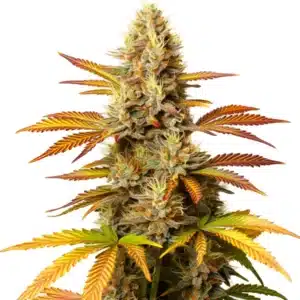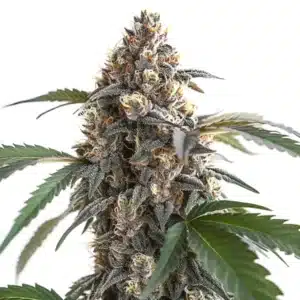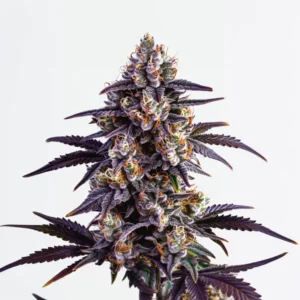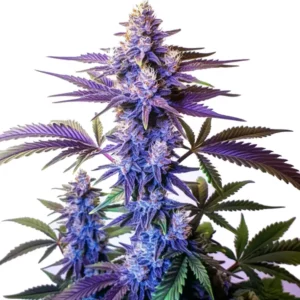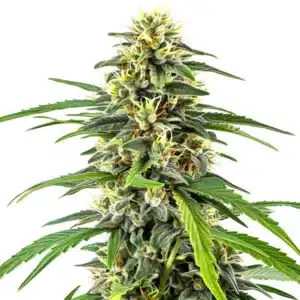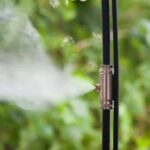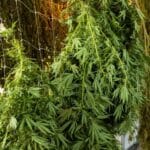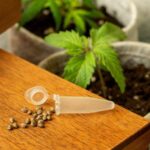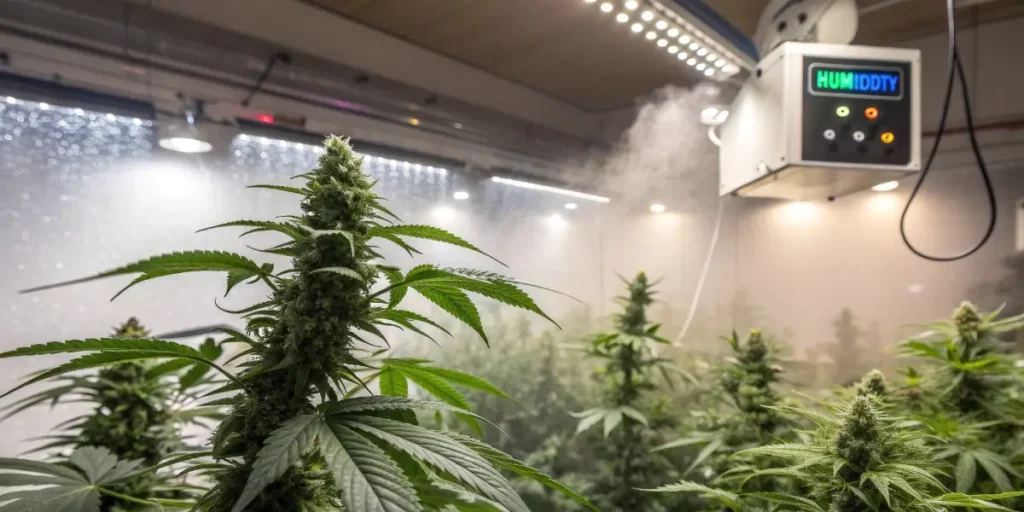
Dehumidifier for Weed: Why It Matters
Humidity in Cannabis Cultivation
Maintaining the right humidity levels is essential for healthy cannabis plants. Humidity impacts everything from nutrient uptake to the prevention of mold and pests. For growers, controlling this factor ensures a consistent, high-quality yield.
Cannabis plants thrive in specific humidity ranges depending on their growth stage. A dehumidifier for weed can help maintain optimal conditions, especially in environments with naturally high humidity or limited airflow.
Recommended Strains
Critical Auto
|
|
THC | 10% - 14% (Low) |
|
|
Type | Autoflowering |
|
|
Yield | Low |
|
|
Phenotype | 70% Indica / 30% Sativa |
Critical Banana
|
|
THC | 22% - 24% (Medium) |
|
|
Type | Feminized |
|
|
Yield | High |
|
|
Phenotype | 50% Indica / 50% Sativa |
Promos & Deals
How High Humidity Affects Weed Growth
Excessive humidity can have devastating effects on cannabis growth. High moisture levels encourage mold and mildew, which can ruin entire crops. Bud rot, a common issue, often thrives in overly humid conditions.
Additionally, high humidity can stunt plant growth by reducing transpiration. This disrupts the plant’s ability to absorb nutrients effectively, leading to deficiencies and lower yields. A quality dehumidifier for weed is an investment in both plant health and final harvest quality. Many growers also wonder, are humidity packs necessary for weed after harvest? The answer depends on storage conditions, but they can help maintain optimal moisture levels and preserve bud quality.
The Benefits of Using a Dehumidifier for Weed
A dehumidifier creates a stable environment for your cannabis plants. By removing excess moisture, it helps prevent mold and ensures proper nutrient uptake. This tool is particularly valuable during flowering, where dense buds are most vulnerable to humidity-related issues.
Using a dehumidifier also improves airflow and maintains consistent conditions, reducing stress on your plants. This results in healthier crops with better potency, flavor, and aroma. Whether you’re growing for personal use or commercial production, a dehumidifier is an essential part of a successful grow room setup.
Choosing the Right Dehumidifier for Weed
Types of Dehumidifiers for Cannabis Grow Rooms
There are several types of dehumidifiers available, each with unique advantages. Portable dehumidifiers are ideal for small grow spaces, offering flexibility and easy setup. Whole-room dehumidifiers are better suited for large-scale operations, providing powerful moisture control for expansive grow areas.
Desiccant dehumidifiers are another option, using silica gel to absorb moisture. While less common, they’re effective in cooler environments. When selecting a dehumidifier for weed, consider your grow room size and environmental conditions.
Key Features to Look For in a Dehumidifier
When purchasing a dehumidifier for weed, prioritize these features:
- Humidity control settings: Allows precise adjustments to meet the needs of your plants.
- Energy efficiency: Reduces operational costs for long-term use.
- Noise levels: Quiet operation ensures minimal disruption, especially in indoor settings.
- Tank capacity or drainage options: A larger tank or continuous drainage system reduces maintenance time.
By investing in a dehumidifier with these features, you can optimize your grow room conditions effortlessly.
Matching Dehumidifier Size to Your Grow Space
Selecting the right size dehumidifier is critical. A unit that’s too small won’t effectively reduce humidity, while an oversized unit may waste energy. Measure your grow room’s square footage and consider the number of plants to determine the appropriate capacity.
For small grow tents, a compact dehumidifier with a capacity of 30-50 pints per day is often sufficient. Larger grow rooms may require units capable of removing 70-100 pints per day or more. Matching the dehumidifier’s capacity to your space ensures efficient and effective humidity control.
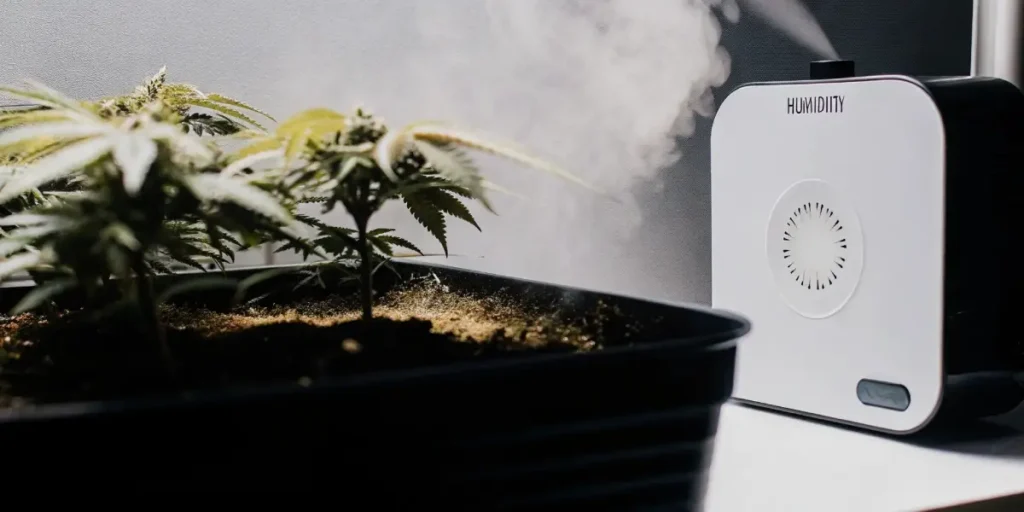
Setting Up a Dehumidifier in Your Grow Room
Ideal Placement for Maximum Efficiency
Placing your adjustable dehumidifier in the right spot ensures it functions optimally. Ideally, the unit should be positioned in the center of the grow room or near the area with the highest humidity. Avoid placing it too close to walls or plants to ensure proper airflow.
If you’re using multiple dehumidifiers for a large grow space, distribute them evenly throughout the room. This ensures consistent moisture removal and prevents pockets of high humidity.
Setting the Correct Humidity Levels for Weed
Different growth stages require different humidity levels. During the seedling stage, humidity should be kept high, around 65-70%. As plants transition to the vegetative stage, lower the humidity to 40-60%. During flowering, maintain levels between 40-50% to prevent mold while supporting bud development.
Most dehumidifiers for weed come with built-in humidity controls. Use these to monitor and adjust levels easily. Consistent monitoring helps avoid sudden changes that could stress your plants.
Maintaining and Cleaning Your Dehumidifier
Regular maintenance ensures your dehumidifier runs efficiently. Clean the filter weekly to prevent dust buildup, which can reduce performance. Empty the water tank frequently or set up a drainage system for continuous operation.
Inspect the unit for any signs of wear or damage, and replace parts as needed. A well-maintained dehumidifier not only lasts longer but also provides reliable humidity control throughout your grow cycle.
Dehumidifiers for Different Growing Stages
Dehumidifier Settings for Vegetative Growth
During the vegetative stage, cannabis plants require moderate humidity levels, typically between 40-60%. A dehumidifier ensures these conditions are met by removing excess moisture. This promotes healthy growth and reduces the risk of mold or mildew developing on leaves.
To optimize your dehumidifier settings, monitor your grow room regularly using a hygrometer. Adjust the dehumidifier as needed to maintain stable levels, ensuring your plants remain healthy and vigorous.
Controlling Humidity During Flowering
Flowering is a critical stage where humidity levels must be carefully controlled. High humidity can lead to bud rot, a devastating issue for cannabis growers. During this stage, keep humidity levels between 40-50%.
Place your dehumidifier near dense bud formations to ensure moisture is evenly removed. Use oscillating fans alongside the dehumidifier to improve airflow and further reduce humidity risks.
Using a Dehumidifier for Drying and Curing Weed
After harvest, proper drying and curing are essential for preserving the potency and flavor of your cannabis. During drying, maintain humidity levels around 50-60% to prevent mold while allowing the buds to dry evenly.
For curing, use a smaller dehumidifier in your curing space to maintain humidity levels at approximately 58-62%. This ensures your cannabis retains its terpene profile and achieves optimal potency over time. A dehumidifier for weed is just as important in post-harvest stages as it is during growth.
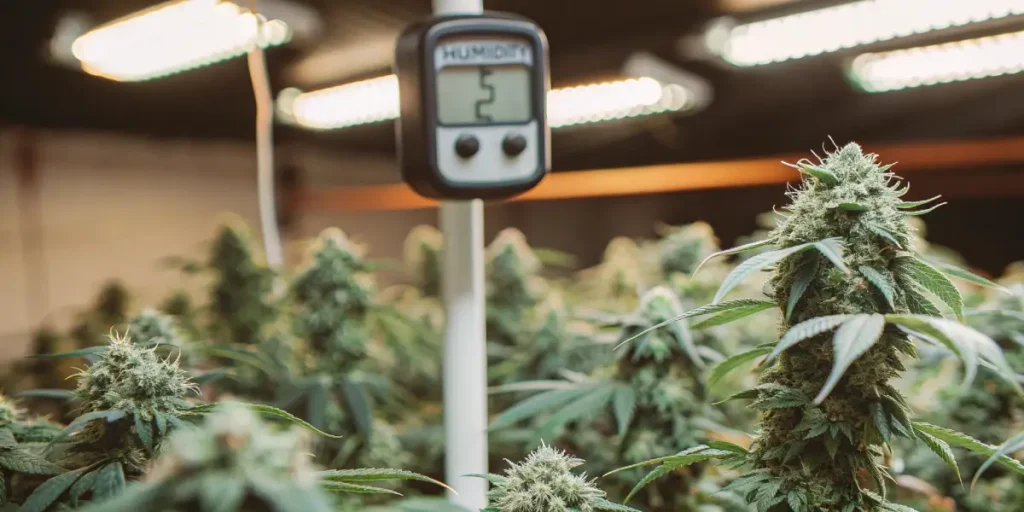
FAQs About Dehumidifiers for Weed
Why is a dehumidifier important for weed cultivation?
A dehumidifier is essential for controlling humidity levels in a grow room. High humidity can lead to mold, mildew, and bud rot, which can ruin your cannabis crop. By maintaining optimal humidity, a dehumidifier ensures healthy growth and higher-quality yields.
What humidity level is ideal for cannabis plants?
The ideal humidity level depends on the plant’s growth stage:
- Seedling stage: 65-70% humidity
- Vegetative stage: 40-60% humidity
- Flowering stage: 40-50% humidity
- Drying stage: 50-60% humidity Keeping humidity within these ranges promotes healthy growth and prevents moisture-related issues.
How do I choose the right dehumidifier for my grow space?
Consider the size of your grow space and the number of plants. Small grow tents may only require a compact dehumidifier, while larger grow rooms need higher-capacity units. Look for features like adjustable humidity settings, quiet operation, and energy efficiency.
Can I use a regular home dehumidifier for my cannabis grow room?
Yes, you can use a regular dehumidifier, but models specifically designed for grow rooms often have features tailored to cannabis cultivation. These include precise humidity controls and higher durability for long-term use in humid environments.
How often should I clean my dehumidifier?
Clean your dehumidifier’s filter weekly and empty the water tank regularly to prevent bacteria buildup. For continuous drainage systems, inspect hoses and connections monthly. Regular maintenance ensures optimal performance and extends the life of your dehumidifier.
Is it possible to overuse a dehumidifier?
Yes, running a dehumidifier excessively can lower humidity levels too much, causing your plants to dry out and become stressed. Monitor humidity levels with a hygrometer and adjust the dehumidifier settings as needed to avoid over-drying.
Can a dehumidifier reduce the smell of cannabis in my grow room?
While a dehumidifier can improve airflow and reduce some odors, it’s not a replacement for a proper air filtration system. Carbon filters are more effective for odor control in cannabis grow rooms.



